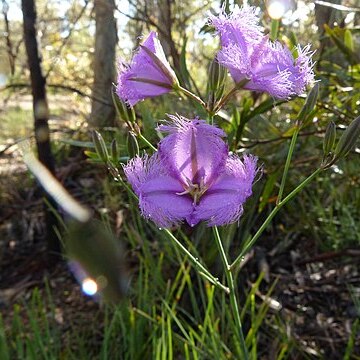Rootstock small; roots tuberous; tubers cylindrical to ellipsoidal, c. 1–2 cm long, 3.5–5 cm from stock. Leaves annual, c. 5–15, linear, channelled below, ±terete towards apex, c. 20–60 cm long. Inflorescence paniculate, 20–60 cm long; umbels 1–8-flowered; pedicels 6–22 mm long, articulated ± medianly. Perianth segments 7–19 mm long. Sepals lanceolate, c. 2–2.5 mm wide, mucronate. Petals ovate, 5–7 mm wide; fimbriae c. 5 mm long. Stamens 6; anthers twisted, 3 outer 2.5–4.5 mm long, 3 inner 3–9 mm long. Style straight to curved, 4–9 mm long. Seeds ellipsoidal, 1.5–2 mm long, 1–1.5 mm wide; aril shortly stalked, yellow to yellow-orange.
An erect herb. It grows 40 cm high. The plant has a ring of narrow leaves. The leaves are 30-40 cm long and 2-3 mm wide. The leaf bases are a dark maroon colour. There is a ring of tubers under the ground. There can be 12 tubers. They are 2-3 cm long and 8-9 mm wide. They are up to 10 cm deep. The flowers are delicate and lilac-mauve. The 3 petals have fringes along the edge. The flowers are 2.5-3 cm across. They are on a central stem 40 cm high. The fruit is a capsule with 3 compartments that contain small black seeds.

